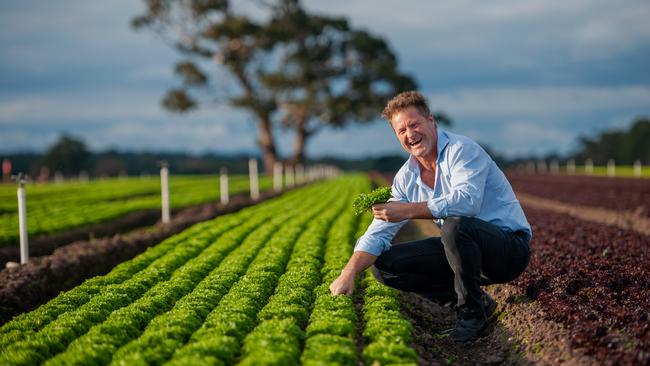No salad days for this lettuce farmer ... despite the prices
With a single head of lettuce selling for up to $12, it would be easy to compare Jeremy Haw to a coal baron or iron ore magnate. But, he says, things are not as they seem.

Jeremy Haw looks across his farm in Maffra, nestled in the Gippsland food bowl, and sees rows of baby lettuces desperately trying to grow in the frost.
Haw is one of the nation’s largest lettuce producers, filling the shelves of supermarkets, hotels, fast-food chains and airlines. With a single head of lettuce selling for as much as $12 it would be easy to compare him to a coal baron or iron ore magnate.
But this is far from true. Lettuce production for his company, Hussey & Co, was running at 200 tonnes a week – spread over several farms in Victoria and Queensland. Now, that output has slumped by almost half.
Poor weather has ruined crops, and what lettuce is growing is weeks behind schedule – if he can find the labourers to pick the crop.
His supply lines are in chaos; new tractors he has ordered now won’t arrive until 2024. His own bills are soaring and there are delays in getting key winter seeds for planting. And when they do arrive, floods and rains could ruin the crop anyway.
Far from being a gold mine, Haw’s Gippsland lettuce farm is actually at ground zero for the maelstrom of economic woe unshackled by the Covid-19 pandemic and now playing out in the form of rampant inflation, especially when looking at higher food prices, labour shortages and a sclerotic supply chain.
But it’s a problem that has been brewing since Covid-19 began, Haw tells The Weekend Australian from his Maffra farm. “When Covid started, food service shut down and a big portion of our business is food service, food chains, and all the restaurants shutting down. We had to plough millions of dollars of lettuce back into the ground, literally, overnight,” he adds.
“And then we tried to work our way back, trying to work out when that demand would come back and that was really difficult. So the losses were very big for us. And anyone in the industry was trying to pick when food service would come back on, but luckily we also supplied retail, supermarkets.”
But then the weather intervened, with his farms under water five times in a year, destroying crops. Overlaying that has been disruptions to supply chains, with something as simple as getting seeds on time thrown into turmoil.
“This season has been completely disrupted. The seed companies need to send their varieties. There are crop failures in Europe and so seeds don’t turn up. The supply chain is getting disrupted from every angle.
“It’s all had a massive impact and that impact is only just starting now to be seen.”
Supply chains slowing down or sometimes breaking down completely is the latest front in the farmers‘ battle.
Given there is a right time to plant and harvest, even a few weeks’ delay can ruin the chances of producing a sizeable lettuce crop. This all constricts supplies and produces the kind of lettuce prices that have become the hot topic at barbecues, dinner parties and water cooler conversations.
Meanwhile, Haw’s ability to get the machinery and equipment he needs to grow his crop and pack it for the shops and customers is being challenged at every level.
“If you look at costs of the supply chain out of Europe or wherever you are trying to buy something, it’s difficult. So I’m trying to buy tractors and have booked the tractors now for 2024 – that’s how far out I’ve got to book tractors to buy new ones.
“It’s ridiculous. You can’t get equipment, you can’t get chemicals, all these different things. You’ve got fuel prices that are obviously killing everybody, plastics have gone up and it just goes on and on. All these things are driving the cost … it will push prices up everywhere which will become inflationary.
“The retailers need to push their prices up. The pressure on farmers – along with the weather, which was an element we just didn’t expect – that is just threatening everything.”
Haw says the weather delivered a blow for Queensland growers, and Victorian farmers which usually pick up the slack have been unable to do so, a problem made worse by the late delivery of lettuce seeds. “You have supply chain issues – seeds that weren’t delivered or not the right seeds … Victoria normally could have filled the supply hole but couldn‘t as those issues came up.”
Haw stresses that despite $12 a head for lettuce farmers are not making ‘‘super profits’’ like those seen in the mining industry as coal and iron ore prices soar. “No one is really making those super-profits. Normally you might have 100 per cent of your crop to sell, but then you have a bad weather event and you lose half your crop, and you only have 50 per cent you can sell and then cover all your costs.
“There is very little profit or no profit at all, as the costs have driven so high that we are actually paying people to take a box of lettuce, so losing money on the sale.”
He is seeing substitution in the market, such as fast food chains Subway and KFC swapping lettuce in their meals for cheaper cabbage, and it is unclear how this might affect consumer tastes.
Haw’s plea to consumers is to support farmers by buying fresh produce, acknowledging that prices are higher and household budgets are being stretched.
“What I think all of us vegie farmers would ask for is that people understand what farmers go through every day.
“Every single day we are working, in the middle of the night, through the day, through bad weather, storms, hail, sunshine, then ducks eating your crop at night. It just goes on every single day and we deliver this bag of salad on the shelf for $3, or whatever it is. The people in the supply chain from the growers all the way through the truck drivers, everyone is working to deliver these products.
“And it’s such a difficult thing for us to get the message to the consumer to say, just understand that it’s a process. Don’t stop eating vegetables, just support the growers because the growers need people to consume. And when it does get back to normal we still have got our market.”






To join the conversation, please log in. Don't have an account? Register
Join the conversation, you are commenting as Logout